The Musicarta Canon Project Module Ten
Mixed Accompaniment Patterns
In the last module, you discovered that the same left hand accompaniment pattern doesn’t necessarily suit all right hand music. In this module, you train your ear to recognize more ‘bald spots’ that need fixing, and get more practice on root-fifth-octave-tenth accompaniment patterns – the raw material of most solo accompaniments.
Here is the module audio performance, demonstrating an improved mixed-type accompaniment pattern.
Earlier treble parts with accompaniment
Rehearse this right hand triad pattern.
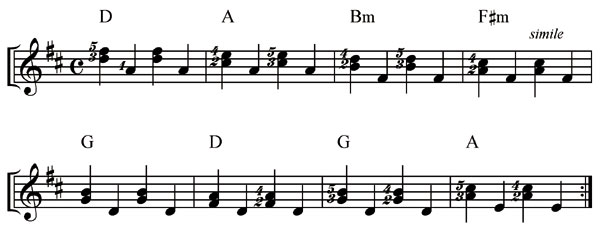
Notice how the fingering changes within the bar to prepare the next chord. The ‘simile’ marking at the end of the first line – Italian for ‘the same’ – tells you to continue using the same fingering solution.
At the low D chord, you change direction, so the ‘solution’ goes into reverse.
Play the right hand pattern over the original R, 5, 8, 10 accompaniment. Use backing track CBT_02.

Complete the chord sequence.
Do you hear any ‘bald spots’ that need fixing?
There are none. We are not kept waiting – listening to ‘bald’ roots, fifths and octaves – to hear a third (the ‘sweet’ chord tone), and the third is not doubled (played in both hands at the same time) either. There is no need to adapt the accompaniment and this variation can go straight into your ‘ready to play’ list.
More LH–RH combinations
Revise this Module Five broken chord pattern.
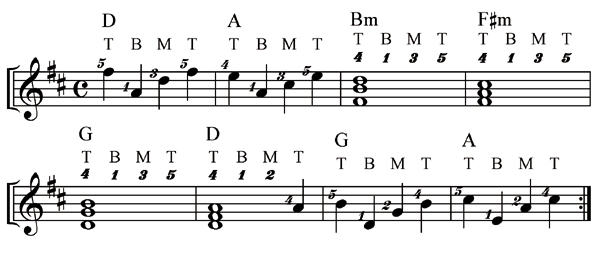
The audio performance file plays the broken chord pattern over a single-note bass line. (It’s always a good idea to build up to creative music-making by rehearsing and then assembling blocks of simpler material you can easily achieve.)
When you have the pattern secure, play it over the standard left hand accompaniment pattern.
Now you hear some glaring bald spots. The right hand plays exactly the same notes for most of the odd-numbered bars. To adjust the accompaniment you will want to play the alternative R, 5, 10, 8 pattern in the odd-numbered bars. We will practice mixing left hand accompaniment patterns on their own first, before playing hands together.
Mixed-type accompaniment patterns
The best way to learn mixed accompaniment patterns is to play them with two hands first. These mixed patterns are quite pleasing on their own. Play them with your classical Canon recordings in the background, or as the bass (secondo) part of a duet.
First, revise the two accompaniment types using hands L, R, R, R.
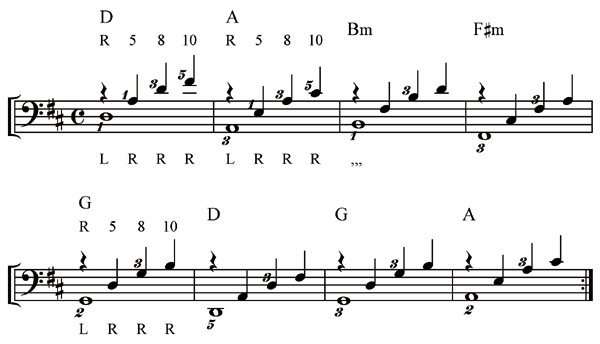
Here’s the second, R, 5, 10, 8 type.
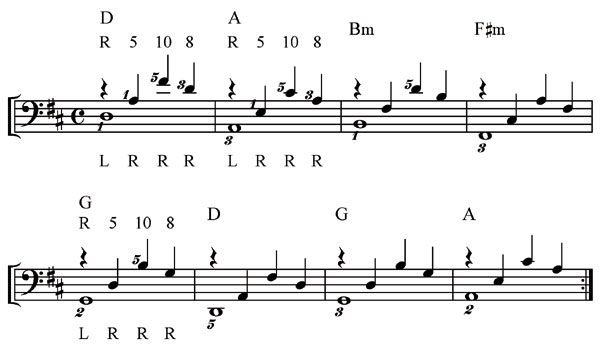
Now play a chorus of the Canon chord sequence starting with the altered R, 5, 10, 8 version in the odd-numbered bars and original R, 5, 8, 10 in the even bars. (Use the altered R, 5, 10, 8 version in bar 8, though. You will see why later.)
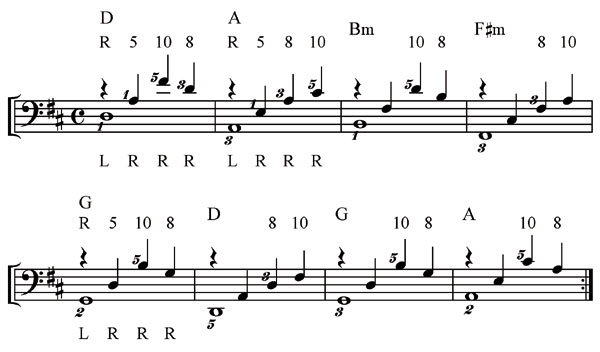
Next, play the ‘mixed type’ accompaniment with the left hand alone, with simple triads in the treble.
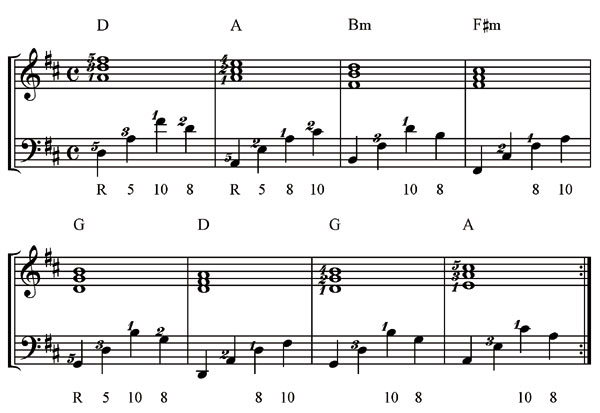
Broken chords over mixed accompaniment patterns
Finally, break up the right hand triads in the broken-chord pattern we are using:
… and play the broken chords over the mixed-type accompaniment.
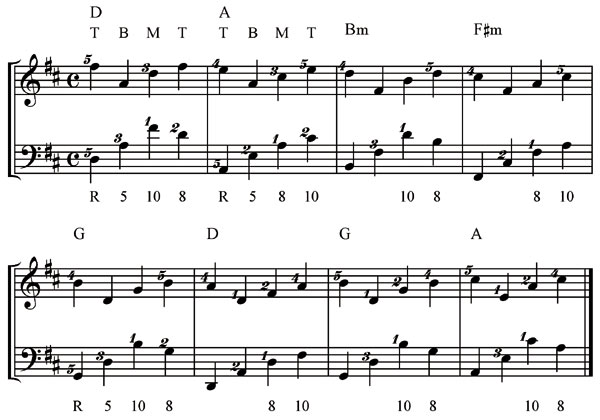
Compare this with the original R, 5, 8, 10 all-the-way-through version to hear how the ‘bald spots’ have been cured.
Audio challenge
Here is our latest version filled out with some ‘in-between notes’ in the even-numbered bars. See if you can work out by ear what they are and play the new version.
The music is in the Answers section.
You can always try squeezing in some ‘in-between notes’ in your own variations. Use backing track CBT_02 to support your performance.
Selecting mixed-type accompaniments yourself
Selecting what accompaniment goes best with a right hand pattern involves listening closely and exercising your artistic judgement – it is an introduction to musical ‘arrangement’.
Here are some treble patterns from earlier modules, played over a simple -one-note bass line. Practice them first, then decide whether they require R, 5, 8, 10 or R, 5, 10, 8 or mixed-type accompaniment.
Type One
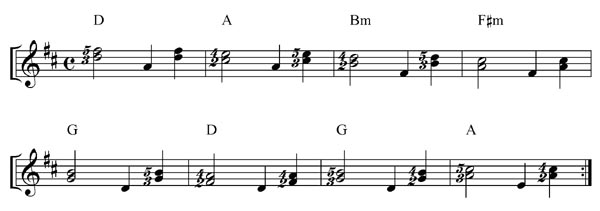
Type Two
Suppose you had a slight variation of this pattern in the next chorus.
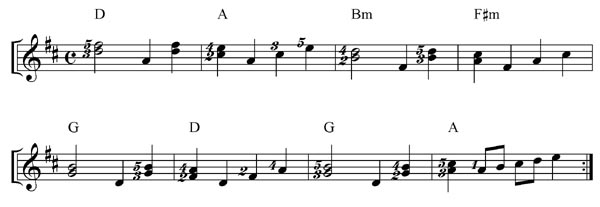
What accompaniment would best suit that right hand part? Join the two choruses together and play with your chosen accompaniment types. You can find the music and the audio and MIDI performance file references in the ‘Answers’ section at the back of the book.
Type Three
What left hand pattern or combination of patterns suits the following right hand material best?
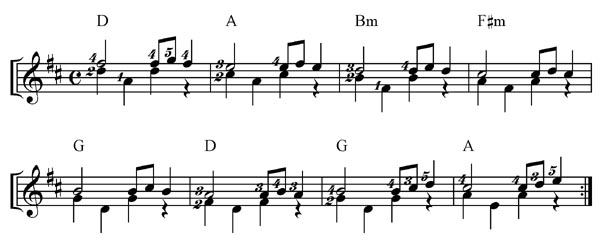
Type Four
What do you think the best accompaniment pattern for the following right hand broken chord pattern (using the usual right hand triads) would be?
- audio pending -
Find some suggested solutions in the ‘Answers’ section.
Type Five
Here is a table version of another mixed-type two-handed accompaniment.

- audio pending -
Note the two-bar chord-tone pattern: R, 10, 5, 8 │R, 5, 8, 10.
Play through the Canon chord
sequence using the same two-bar pattern.
This pattern sounds very pleasant just on its own, and would also be useful as the lower part of a duet (the ‘secondo’). Try playing it from the table, then check your performance in the ‘Answers’ section.
Answers
Type One

Type Two

- video pending -
Type Three

Type Four
(Right hand pattern)
Type Five

Thanks for visiting MUSICARTA! Come again soon!
|
|
Get an overview of Musicarta in manageable monthly slices – and keep up to date with new postings.
Read all about it on the Musicarta Newsletter page. The Musicarta News - regular encouragement to learn and progress! Or – get the Musicarta RSS feed. [What’s that?] |
|
OUT NOW! |
THE MUSICARTA BEAT & RHYTHM WORKBOOK At last! An effective approach to keyboard rhythm & syncopation skills. Learn more! |
ONLY $24.95! |





 THE LOGO
THE LOGO















